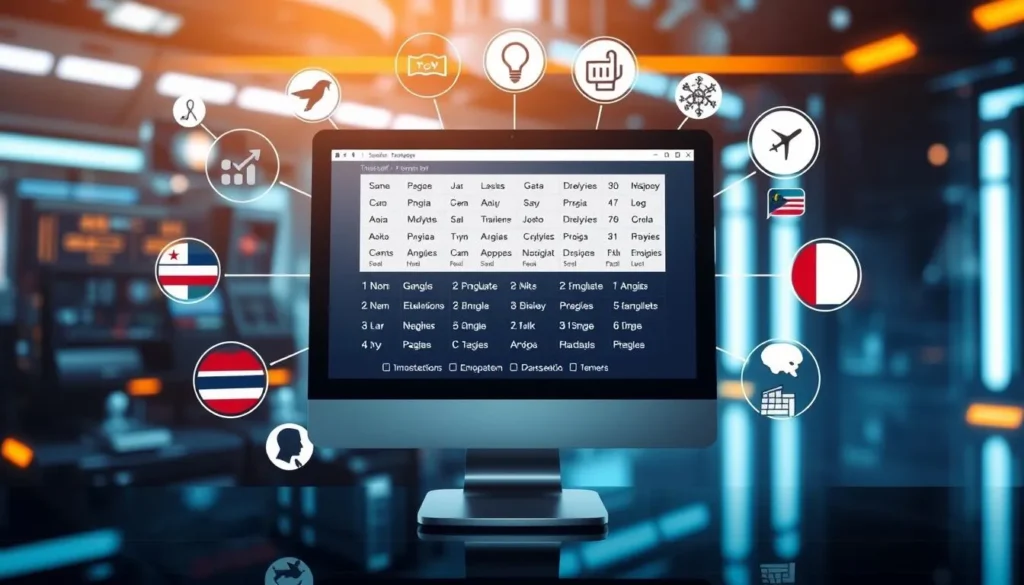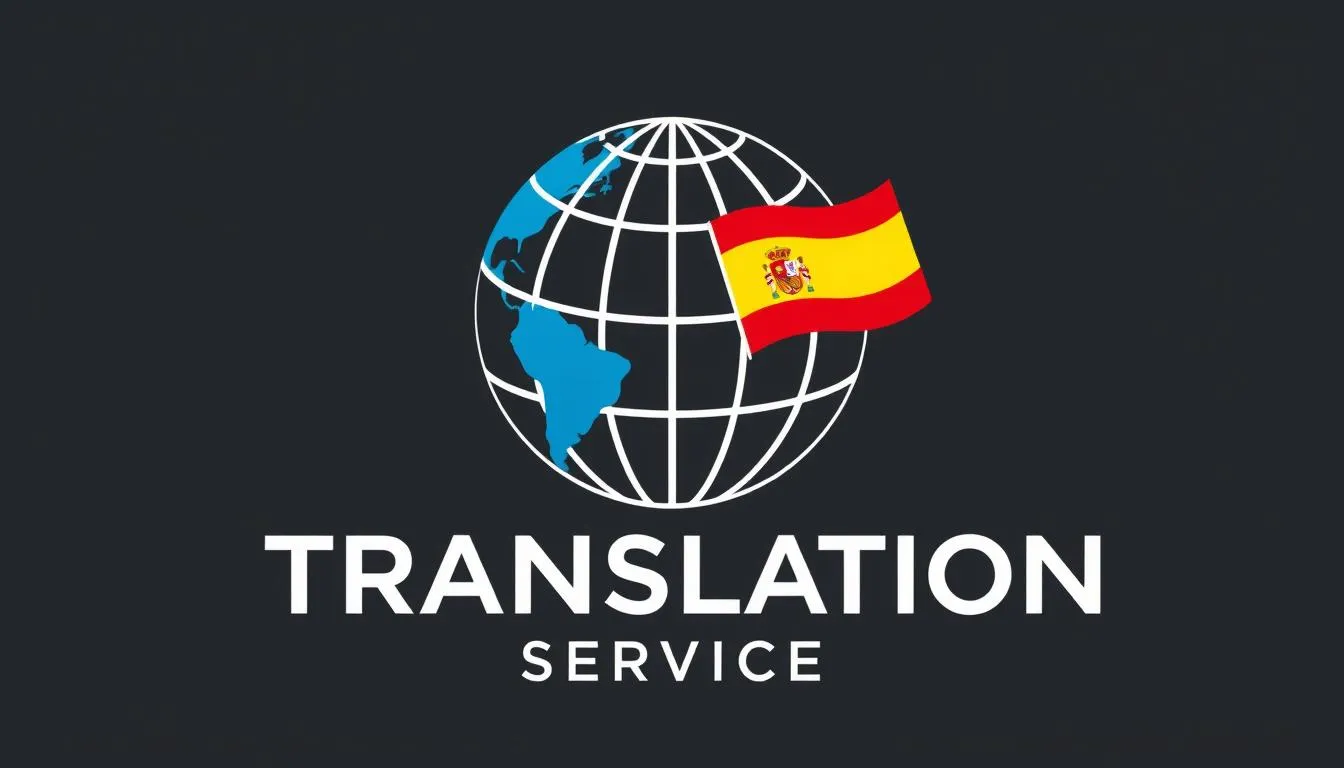A professional translation service logo featuring a globe icon with spanish flag elements, clean modern minimalist design
A professional Spanish translator helps bridge language gaps with precision. They are vital for accurate communication in global business.
Skilled translators do more than just change words. They capture hidden meanings and cultural nuances that machines can’t.
Professional translation is key to success in many areas. It helps with business growth, marketing, and talking to global partners.
Quality language services need deep language skills and cultural know-how. They also require expert knowledge in different fields.
Picking the right Spanish translator can boost your communication power. It can open up new chances for success.
Our guide will teach you about professional Spanish translation. You’ll learn how to make smart choices for better communication.
Why You Need a Professional Spanish Translator
Professional Spanish translators offer more than simple word conversion. They bring vital cultural expertise to your communication needs.
Accurate translation captures the essence and context of your original message. It prevents mistakes that could harm your relationships or reputation.
Cultural understanding is key in effective translation. Native speakers recognize subtle language nuances that machines often miss.
Professional translators bridge communication gaps effectively. They provide translations that resonate with your target audience’s cultural expectations.
Businesses gain an edge with professional translation services. Accurate translations show respect and professionalism to international clients.
The right translator turns language barriers into growth opportunities. They help you connect better in Spanish-speaking markets.

Types of Spanish Translation Services
Spanish translation services help bridge language gaps. They offer expert solutions for businesses and individuals.
Document translation is key for many organizations. It ensures accurate communication of legal, medical, and business papers.
Website localization adapts content for Spanish-speaking audiences. It considers cultural context, idioms, and regional preferences.
Audio and video transcription helps reach wider audiences. It turns spoken words into written text, capturing language nuances.
Simultaneous interpretation provides real-time language conversion. It’s crucial for international conferences and live events.
These services offer tailored language solutions. They help organizations communicate effectively across different languages.
How to Choose the Right Spanish Translator
The right Spanish translator can greatly improve your translation project. Focus on key factors for accurate and reliable results.
Translator qualifications are vital. Look for certifications from reputable organizations like the American Translators Association (ATA).
Specialized translation needs more than basic language skills. Each industry has unique terminology and communication needs.
For legal, medical, or technical translations, find professionals with specific experience.
Check portfolios to see a translator’s expertise. Review work samples, client testimonials, and professional references.
Look for native-level language skills and subject knowledge. These are signs of a quality translator.
Consider turnaround time, pricing, and communication skills. A great translator captures meaning and cultural context.
Choosing the right translator prevents misunderstandings. It ensures your message is clear and effective.
The Benefits of Hiring a Spanish Translator
Spanish translators are key for entering Spanish-speaking markets. They help bridge gaps and open new doors.
These experts navigate cultural nuances well. They ensure clear and accurate message delivery.
Quality translation services boost client communication. Customers feel valued when info is in their language.
This creates trust and shows commitment. It also prevents harmful misunderstandings in business.
Expert translation support makes business growth easier. Companies can approach new markets with confidence.
Translators adapt marketing, legal, and technical content professionally. They transform your whole communication strategy.
Spanish translators do more than just convert words. They understand cultural context and regional dialects.
They also know industry-specific terms. This helps businesses avoid communication mistakes.
Translators present a polished image in global markets. They’re crucial for international success.
Understanding the Translation Process
Spanish translation starts with a needs check. Experts look at what the project needs to succeed.
This step helps capture the true meaning of the content. It goes beyond just words.
Translators carefully work through the text during drafting. They use their deep knowledge of Spanish language details.
The focus is on natural, culturally fitting communication. It aims to connect with the target audience.
Quality checks are key in professional translation. Experts use many review stages to ensure top-notch work.
These steps help catch errors and boost accuracy. The goal is to achieve the best language precision.
The last step is a full quality check. Translators make sure terms, grammar, and cultural fit are spot-on.
Special tools help validate every part of the translation. This ensures a polished, pro-level result.
Clients can expect teamwork throughout the process. Translators stay in touch and address any concerns that come up.
Tools and Technology Used by Spanish Translators
A computer monitor displaying translation software, with various language symbols and icons surrounding it, set against a futuristic, high-tech background.
Spanish translators use modern tools for precise and quick results. Translation memory software is key, helping them reuse past translations.
They also use special glossaries to keep terms consistent. These digital resources capture industry-specific language details.
New tools now use AI and machine learning. These help translators work faster and reduce manual tasks.
Cloud platforms allow easy teamwork between translators, editors, and clients.
Translation memory software tracks past work. It suggests matches for similar text, saving time.
Translators can adjust these tools to meet client needs. They also use them to follow industry rules.
Complex Spanish translations benefit from advanced glossaries. These help keep terms accurate in fields like tech and medicine.
Common Challenges in Spanish Translation
Spanish translation is more than just swapping words. It’s a complex task that requires skill and deep understanding.
Spanish dialects vary greatly between regions. This can cause confusion if not handled carefully.
Technical translation demands precise knowledge. Translators need expertise in specific fields to convey complex ideas accurately.
Words acceptable in one country might offend in another. Skilled translators must know local idioms and cultural contexts.
Keeping the original tone and style is crucial. Translators must capture the intent and cultural essence of the message.
Professional Spanish translators train for years. Their expertise ensures accurate translations for different Spanish-speaking audiences.
The Role of a Spanish Translator in Marketing
Spanish marketing translation is more than just changing words. Professional translators help brands connect with Spanish-speaking audiences in different regions.
Content localization needs a deep understanding of cultural nuances. Skilled translators adapt messages to fit local tastes and sayings.
Successful campaigns need cultural relevance. Translators study language details to speak authentically to each Spanish-speaking group.
They know regional dialects and cultural sensitivities. This helps avoid mistakes that generic translations might make.
Brands using professional Spanish translation gain big advantages. They can build trust and grow in Spanish-speaking markets.
A key strategy is transcreation. It reimagines content to keep its impact while respecting culture.
This method ensures marketing messages stay powerful across different languages.
Pricing Models for Spanish Translation Services
Spanish translation pricing helps businesses plan their language needs. Rates vary based on key factors. Most translators charge per word for standard documents.
Specialized projects may cost more due to content complexity. Different pricing models suit various client needs. Per-word pricing is the most common approach.
Large projects might get volume discounts, reducing rates by 10-15%. Project-based pricing works for comprehensive language services. Retainer agreements can lower long-term costs for consistent needs.
Factors affecting pricing include document complexity and turnaround time. Urgent translations often cost more. Companies should compare rates from multiple services.
Quality Spanish translation ensures accurate, culturally appropriate communication. It can help expand your business reach. Choose a translation partner based on quality, not just cost.
FAQs About Spanish Translation Services
Clients often ask about Spanish translation services. Most projects take 1-5 days, depending on length and complexity.
Clients can give custom terms for their industry or brand. This helps capture precise language and unique communication styles.
Translators welcome style guides and glossaries to stay accurate.
Project scope affects costs. Rates depend on length, complexity, and turnaround time.
Many services offer free talks to discuss project needs. Expect clear pricing that shows exact costs upfront.
Quality checks are key in Spanish translation. Good translators use multiple review steps.
Native Spanish speakers with expert knowledge ensure top-notch translations.
Clients can help by giving clear documents and audience details. Digital files in editable formats work best.
Success Stories: How Spanish Translation Helped Businesses
Spanish translation services have boosted many businesses. Spotify’s growth in Latin America is a great example.
They used top-notch Spanish translation and local culture knowledge. This helped them gain 40% more users in two years.
Coca-Cola’s success came from a smart two-language campaign. They made content that spoke to both English and Spanish speakers.
This led to more people liking the brand. It also helped Coca-Cola reach new markets.
Adobe did well by translating all their products into Spanish. They made their software easy to use in Spanish.
They also translated their help guides and customer support. This grew their worldwide customer base.
These stories show how important language services are for business. Good translation can open new markets for companies.
It can help build better ties with customers. It can also lead to big growth in today’s global market.
Next Steps: Hiring Your Spanish Translator
Start by researching qualified professionals through reputable platforms like ProZ, ATA, or LinkedIn. These networks can connect you with experienced translators in your industry.
Prepare interview questions to assess their expertise. Explore their certifications, subject knowledge, experience, and familiarity with industry-specific terms.
Request sample translations and verify their credentials. This ensures high-quality work for your project.
Discuss project scope, deadlines, rates, and revision policies before finalizing the agreement. A comprehensive contract should outline confidentiality terms and payment structure.
Clear communication helps prevent misunderstandings and ensures a smooth translation process. Take time to review portfolios and check references.
Select a professional who understands your specific translation needs. This investment will result in accurate, culturally appropriate translations for your business.click here for more info.
FAQ
How long does a typical Spanish translation project take?
Spanish translation timelines vary based on document length and complexity. A 1,000-word document usually takes 1-2 business days.
Specialized or technical documents may need extra time for accuracy.
What qualifications should I look for in a Spanish translator?
Seek translators with native fluency and professional certifications like ATA. Look for specialized expertise and proven experience in your industry.
Advanced degrees in translation or linguistics are also valuable.
How do you handle different Spanish dialects?
Our translators understand regional language variations. We adapt translations to specific Spanish variants for your target audience.
This ensures content resonates with readers in Mexico, Spain, Argentina, or elsewhere.
What types of documents can be translated?
We translate legal, medical, business, marketing, and technical documents. We also handle websites, academic papers, and personal documents.
Our translators specialize in various fields for accurate translations.
How do you ensure translation accuracy?
Our process includes translation, proofreading, editing, and final quality assurance. We use translation memory software and specialized glossaries for consistency.
Can you provide certified translations?
Yes, we offer certified translations for official documents. These come with a signed accuracy statement.
Our certified translations are accepted by government agencies and institutions.
What are your translation rates?
Pricing depends on word count, complexity, and turnaround time. Rates vary for specialized translations.
We offer competitive pricing and free quotes for your project.
Do you offer localization services beyond translation?
Yes! We provide comprehensive localization services. We adapt content to cultural nuances and modify images.
Our goal is to make translated material feel native to Spanish speakers.
How do you protect client confidentiality?
We take confidentiality seriously. Our translators sign non-disclosure agreements and use secure file transfers.
We have strong data protection protocols throughout the translation process.
What is your turnaround time for urgent translations?
We offer expedited services for urgent projects. Many translations can be completed within 24 hours.
Rush services are available for a small fee to meet critical deadlines.

